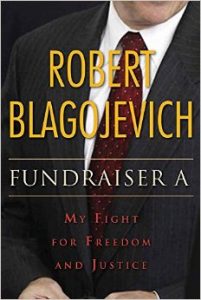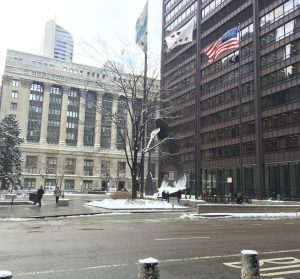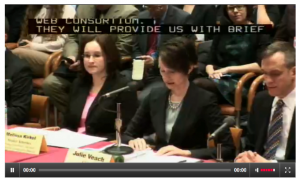Yasmin Mohamed, a Somali refugee living in Chicago, endured one of the globe’s greatest humanitarian crises, but understanding her future means journeying to ZIP code 60625.
Four mornings a week Yasmin winds her way down Whipple Ave. to the Albany Park Community Center. The second floor classroom is a global village of 26 students from 13 countries. Class starts promptly at 8:30 a.m. The diverse tongues quiet down and the teacher steps from behind her desk to give the class its first assignment. “Talk about the time that you moved.”
Yasmin grips a yellow pencil and spreads her red Nikes wide across the floor. She drags her desk across the blue and gray tiles to sit by a classmate, a polite refugee from Afghanistan. The wall a few feet away is lined with the English alphabet. K stands for King, a reminder of the preacher who once spoke in Africa about justice’s triumph. Sunlight beams in from a window overlooking Kimball Ave.
Yasmin’s first memories are of Kakuma, a refugee camp in northwest Kenya. It’s about 600 miles west of the Somali capital of Mogadishu. Yasmin says the camp was violent.
Roaming gangs and ripping bullets might rule the night. “I don’t remember Mogadishu. I remember Kakuma,” Yasmin says.
Warring Clans ruled the Somali capital. “Mogadishu all of the time fighting. No peace,” Yasmin said. The past is heartbreaking, it’s “sad,” she added.
Yasmin came to the United States on April 5, 2007 at age 21. Four days later she enrolled in English class.
One journey ends another begins
When a voyaging refugee arrives in Illinois, they’ve prevailed through humankind’s darkest nights. For Yasmin, and more than 1,400 other Somalis, the land of Lincoln offers safe harbor from the storms of famine and violence.
As Yasmin prepares for the Midwestern winter, turmoil persists in east Africa. A September report by the United Nations High Commissioner for Refugees says 530,000 Somalis are refugees, and another 1.5 million have been displaced from their homes. Public resources in the U.S. might be unimaginable to hundreds of thousand of African refugees, but Yasmin’s life will forever be linked to them, and to Somalia’s history that has forced millions to flee their homes.
Challenges
As coffee brews and break time approaches, teacher Lindsay Crammond paces between conversation groups. Yasmin understands how important education is, Crammond says. Yasmin’s life is a perseverance lesson. “This person spent 13 years in a refugee camp, you don’t learn job skills there. You learn life skills,” adds Crammond.
While the classroom is warm and welcoming, the U.S. economy is not. Like so many who have made it to the United States, Yasmin remains challenged by economic insecurity.
Yasmin met her husband in Africa, and they came to Chicago together. For Yasmin finding employment was challenging in her new country. “I looked for a job everywhere,” she said. Her husband found work pushing wheelchairs at O’Hare Airport. Trouble came when he lost his job.
The two decided to move. At one point she was in Minnesota looking for a job while he pursued meatpacking work in Nebraska. They talked on the phone but longed for each other. When Yasmin landed a part-time janitor’s job they reunited. “When I got this job I rent apartment so I told him to come back Chicago, and he come back, and he’s here right now,” she said.
“I am cleaning the offices,” said Yasmin, who has balanced work with school. She had to miss class once for work. Like a trustworthy friend, she came by class to let Crammond know the reason for her absence.
Many of her co-workers are Mexicans; she likes them, but wants more opportunities. She cooks at her apartment and finds sanctuary in study. “I want to write complete sentences,” she says.
She walks confidently through the school, wearing a brightly colored hijab, the traditional Muslim headdress. Occasionally she smiles, and in that expression a united and peaceful Somalia seems possible. “I think I will be a good writer; I think I will be able to speak English very good,” added Yasmin.
Fractured Somalia
David Shinn, former U.S. ambassador to Ethiopia, said Somalia had no central government. He said the country, located 200 miles south of Yemen, had a U.N.-backed temporary government controlling a tiny part of Mogadishu. Two other militant Islamic groups control a larger part of the country, he said.
Scant media attention makes it difficult to understand what is happening in the country. “The problem, of course, is it’s very difficult to get into Somalia right now,” says Shinn, an associate professor of international affairs at George Washington University.
Shinn said relief agencies consider Somalia the world’s greatest humanitarian crisis.
He said the U.S. greatly reduced its humanitarian assistance after 18 soldiers were killed in October 1993. The “Blackhawk Down” incident led Western governments to shift troops and resources away from Somalia.
War, drought and exile continued. Attention shifted back after 9/11, and particularly since the anti-western Islamic Courts Union came to power in 2006. A recent food shortage might have made the inhumane living conditions into the grossly inhumane.
Hope for peace
Each new refugee brings personal sadness and heartache to the U.S. But, they may find hope, just as Yasmin did when her anchor dropped in a Chicago English class.
“When I come here I didn’t speak English well. But now I’m better. I hope I will be better than this,” said Mohamed.
The refugee who now has friends near the shores of Lake Michigan said, “I would like to go back someday and see my people.”
She hopes to see her homeland.
“If it’s peaceful.”
MORE ON THE BROADER REFUGEE EXPERIENCE
What it means to be a refugee
By Christopher Pratt
Pirates and warlords don’t rule in the U.S. but money matters in a big way. One refugee challenge is paying rent with a relatively meager sum they typically get from the government. “Refugee cash assistance is $243. And that refugee is facing $550 to $650 rent,” said Ed Silverman, the state’s refugee coordinator.
Last year the non-profit community in Illinois raised $1 million to ensure adequate services for refugees, said Silverman. Funding refugee resettlement is a constant challenge, but particularly in this recession, he added. Support from organizations like World Relief is important to the resettlement process, and their staff work is critical.
Silverman said more than 50,000 African refugees live in Illinois.
Most U.S. refugees depend on public aid to resettle. The Refugee Act of 1980 directs the U.S. Department of Health and Human Services to work with non-profits and states to resettle refugees — people that the U.N. says have well-founded fears of persecution in their homeland.
Silverman began working in refugee assistance more than 30 years ago. “We are in a global community. People have a right to earn a living and provide adequate education for their children,” said Silverman.
The 1980 law was one of the late Sen. Edward M. Kennedy’s legislative accomplishments, added Silverman. Kennedy once said the country had a humanitarian- and a foreign policy-interest in welcoming refugees. In 1981 over 150,000 refugees resettled in the U.S. By 2006 it was just 42,000. The refugee law allowed the president to determine, on an annual basis, how many refugees could immigrate, and left Congress to decide how to fund the program. In recent years the refugee ceiling rose but funding decreased.
















Be First to Comment